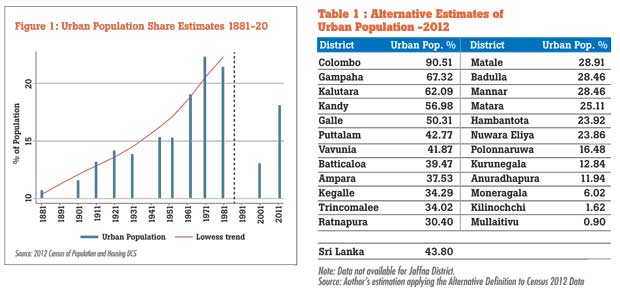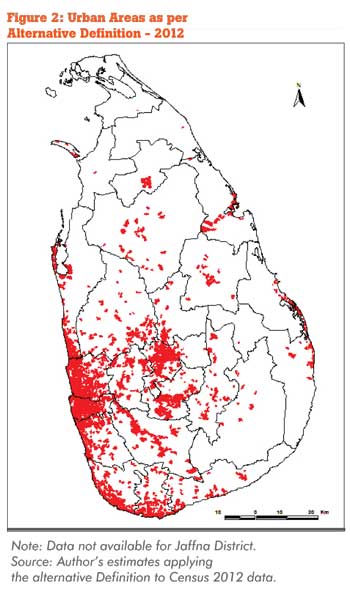06 Apr 2016 - {{hitsCtrl.values.hits}}


Sri Lanka has a visibly high rate of urbanization and ambitious plans for further urbanization through the envisioned Western Region Megapolis Project. Nonetheless, the latest official statistics indicate that only 18.2 percent of the population lives in urban areas. This does not reflect the true level of urbanization in Sri Lanka. The World Bank notes that ‘while urbanization data in Sri Lanka are much debated, there is a consensus that the country is urbanizing faster than the statistical figures suggest’.
Similarly, in many cities in Sri Lanka, the true extent of the city extends beyond its administrative boundaries, while as much as one-third of the population may be living in areas that ought to be classified as urban areas. Reinforcing these views, the Department of Census and Statistics (DCS) confirms that the current definition underestimates urbanization and that the urban population `would have been much higher if the definitional issues were resolved’.
Current definition
As per the current definition, Municipal and Urban Councils are considered urban areas. Until 1987, Town Councils (TCs) were also urban. With the 13th Amendment to the Constitution, TCs were abolished and absorbed under the Pradeshiya Sabhas, which are considered rural. The vertical line at 1987 in Figure 1 depicts this change and the associated urban population share estimates before and after 1987.
In this context, as noted by the DCS, ‘it is important to introduce a realistic definition of urban areas taking into account the characteristics of the population rather than based on administrative considerations alone’.
Definitions in other countries
There is no universally accepted definition for ‘urban’ and every country defines urban independently. In 2011, out of the 231 countries reported in the World Urbanization Prospects, only 28 percent used a pure administrative definition, while most countries used criteria such as urban characteristics, population size and population density to distinguish urban areas. Some countries used a combination of population and geographic characteristics with administrative criteria. India, for instance, defines urban as areas which have a minimum population of 5,000, a minimum density of 1,000 persons per square mile and at least 75 percent of the adult male population being employed in non-agriculture activities.
A new definition
A forthcoming study by the IPS suggests an ideal definition for urban areas in Sri Lanka, defined at the Gramaseva Niladhari Division (GND) level, using four indicators. Minimum population and population density reflect the social characteristics of urban population, while the plot area ratio and non-agriculture employment ratio reflect the ecological and economic elements, respectively.
However, until the appropriate data becomes available, this ideal definition also fails to address the current issues of an urban definition and estimates.
Nonetheless, the same study develops a more practical Alternative Definition, which uses proxies for unavailable data and defines urban areas as follows.
Alternative definition
If a GND has a minimum population of 750 persons, a population density greater than 500 persons per km2, firewood dependence of less than 95 percent households and well-water dependence of less than 95 percent households, such a GND is defined as an urban area.
In this instance, dependency shares are defined as the share of households relying on firewood or well water as the principal source of cooking fuel or drinking water, respectively. The existence of a well indicates the availability of open space in a plot, hence a proxy for plot area ratio. Its validity is justified based on building guidelines (minimum distance of 18 meters between the well and soakage pit of a septic tank, minimum distance of five meters between the soakage pit and nearest building and minimum distance of three feet between the well or septic tank and boundary walls) and statistics (94 percent of households rely on septic tanks/pits and 50 percent of households rely on well water).
Similarly, the validity of cooking energy as a proxy for economic element rests on the Energy Ladder hypothesis and the related nexus between higher per capita incomes, increased urbanization and replacement of traditional energy sources with modern ones. Studies show that Sri Lanka as a whole is moving away from traditional fuels towards modern ones, while relying on a portfolio of fuels, in which the type of energy used is associated with income, where the use of firewood declines when income increases.
In this alternative definition, the cut off values of proxies are justified by data –where over three-fourth of the GNDs have a well water dependency less than 95 percent and a half of GNDs have a firewood dependency less than 95 percent. For population level and density, the critical values are reasonable for Sri Lanka, compared with definitions in other countries and justified by data.
Alternative estimates
Combining these criteria 3,659 GNDs can be identified as urban (see Figure 2), which accounts for an urban population of 8,334,801 persons. The Colombo District has the highest share of urban population (90 percent) followed by Gampaha and Kalutara (see Table 1).
This alternative definition estimates 43.8 percent of the Sri Lankan population to be living in urban areas, which is very close to the 48 percent quoted by the Megapolis and Western Development Minister and the 47 percent estimated by the Agglomeration Index (AI).
Advantages
The advantage of this alternative definition over the AI is its appropriateness for Sri Lanka due to the use of country-specific characteristics and critical values. This new definition also improves on the rigidities of the existing definition and can be applied to many datasets such as the Household Income and Expenditure Survey to obtain data with diverse variables to conduct in-depth research on urban housing, health and employment, to name a few. Such research would be invaluable for the success of the planned Western Region Megapolis Project.
(Dr. Bilesha Weeraratne is a Research Fellow at the Institute of Policy Studies of Sri Lanka (IPS). To view the article online and comment, visit the IPS blog ‘Talking Economics’ – www.ips.lk/talkingeconomics)
26 Nov 2024 9 minute ago
26 Nov 2024 18 minute ago
26 Nov 2024 1 hours ago
26 Nov 2024 2 hours ago
26 Nov 2024 2 hours ago